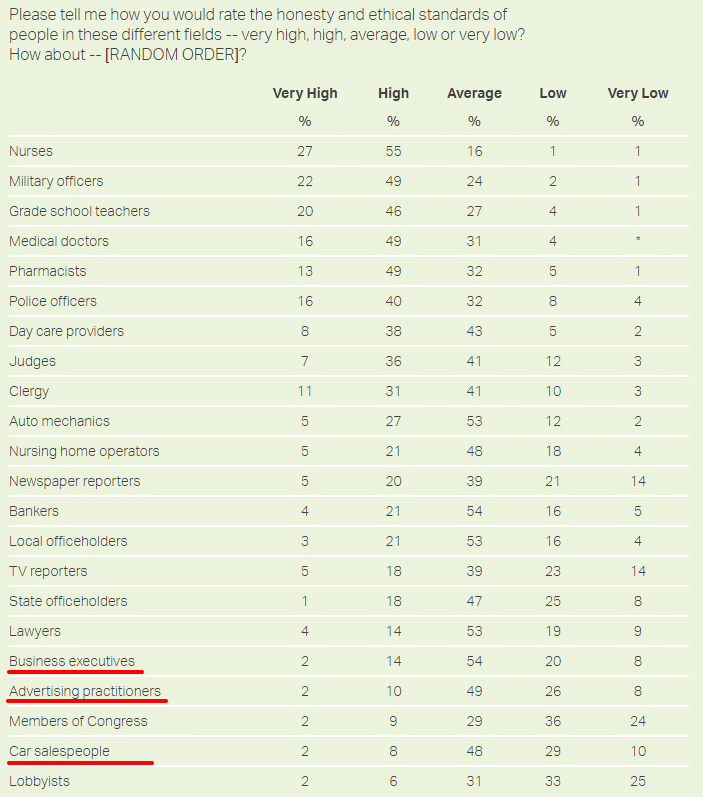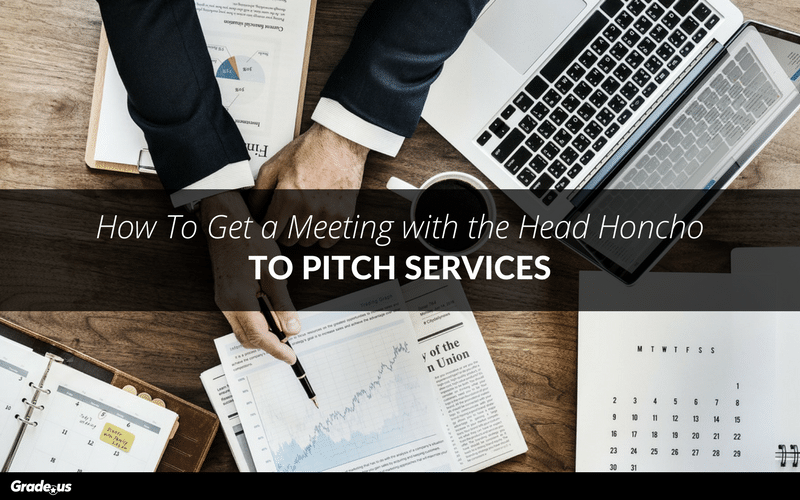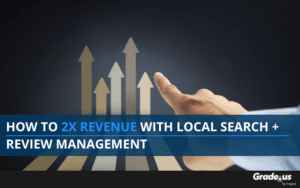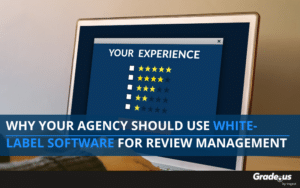If you need to reach decision makers, you’ll need to know how to get a meeting first. If you’re an experienced seller, you know how tough this is.
Decision makers instruct gatekeepers to screen salespeople out. Busy executives do everything they can to avoid them. Culturally, they're viewed as a manipulative nuisance, the kind of distraction customers steer clear of.
We all know why.
There's a variety of reasons, but they all boil down to one thing. Salespeople are viewed as inherently selfish. In the minds of most customers, they're focused on taking rather than giving.
Salespeople are inherently dangerous
They're risky.
It's not the salesperson in particular, but their alignment in general. Typically, their goals aren't automatically aligned with your own. If you're like most professionals, you're running from one fire to the next. You're exhausted, overworked and (often) underpaid.
There simply isn't enough of you to go around.
But there's always someone asking for more help, isn't there? Another customer, colleague or friend looking for your "support" with yet another problem.
Then these "salespeople" show up.
These parasites arrive with their hands out, looking to suck up as much as they can. They want your time, money and resources - as much as you're willing to give, as often as you're willing to give it.
Did you catch that?
The latent hostility in my tone as I talked about the salespeople looking to take from you? You probably know what I'm talking about, right? Here's the thing about that.
That's how customers feel about you.
If you ask customers for anything, if you take before you give, you automatically become the enemy. As an outsider, this doesn't make a whole lot of sense - which is why I started this article the way I did.
Why is that?
"Nobody likes being sold, but everybody likes to buy"
Remember that saying?
This is why it's so hard to get a meeting with decision makers. Salespeople are viewed with severe disdain. Almost as if they're desperate vampires, freelance bottom feeders looking to take as much as they can from unknowing customers.
No one wants to be a sucker.
And there lies the problem. If you're sold then that means you were outdone, defeated. You're a sucker, the mark salespeople laugh about in the break room.
Buyers, on the other hand, are shrewd and discerning.
They're wise and appropriately skeptical. Difficult to take advantage of. The vast majority of customers want to be seen as buyers, not suckers. If you want something from a prospect, you're automatically viewed as a salesperson (which most customers despise).
But why?
When Gallup rated the honesty/ethics in professions, salespeople weren't viewed favorably.

What is it about salespeople that makes them so undesirable? Salespeople are viewed as...
· Selfish. When they interrupt you many salespeople aren't considerate of your time. Aggressive salespeople push on ahead anyway, working to get what they want from you, their unhappy prospect.
· Untrustworthy. Salespeople are often viewed as untrustworthy. Customers seem to believe salespeople are willing to lie (and justify that lie) to get whatever it is they want.
· Boundary-less. It's common for salespeople to violate social norms, to ignore hints, gentle letdowns and explicit No's from customers. It's the reason prospects ignore sellers they aren't interested in. They're afraid these sellers won't take No for an answer.
· Completely uninformed. It's common for salespeople to misunderstand their customers' needs. Often times they misdiagnose the problem and pitch the wrong solution.
· Needy. "I'd love to tell you about our products and services" or "what would it take to earn your business?" or "I'm calling again to tell you about our [product], when would be a good time for us to connect?" Sellers focus on themselves rather than serving their customers.
· Poor. Underperformers mistakenly believe being "poor" is all about money. It's actually about your spirit, the attitude you bring to the table. Are you presenting yourself as an authority, equal or subordinate? The vast majority of sellers grovel, which immediately turns buyers off. In fact, nothing is more appealing than the salesperson who can immediately and confidently walk away.
Is it any wonder decision makers avoid sellers?
Then there's the typical advice handed out by coaches which only serves to make the problem worse.
These coaches hand out bad advice like:
· Sales is a numbers game. This sounds a lot like you're supposed to keep using the same bad strategy, only with more people.
· Be persistent. Consistently work to "follow up" with your prospects with clever quips like "hi I'm just checking in" and the classic "did you have a chance to look at my proposal yet?"
· Create urgency. It's fine if the urgency is legitimate. Here's the problem with urgency. Often times it's not urgency, it's false scarcity. The salesperson has a quota to meet, wants to increase their numbers, or something artificial.
Salespeople displaying any one of these behaviors don't get meetings. They're blocked, ignored or rejected. They're quietly blacklisted by the very same prospects they claim to serve.
This is the toxic environment you'll be selling in
You want a meeting.
Maybe you're looking to pitch your review management services to an executive. Maybe it's accounting, design or engineering.
It doesn't really matter.
The head honchos don't know you. These decision makers don't care about your services. They're not interested in your "offerings." They're definitely, absolutely not interested in setting up a time to talk.
Not yet anyway.
They're looking for a solution to their problems, a fire extinguisher for their fires.
That's it.
You’re looking to make a cold approach. You want to get a meeting with key decision makers. If this was an inbound lead, things would be different. In that case, decision makers and influencers typically make the first move.
At a minimum, they’ve decided your company is worth looking into.
Not so with a cold approach.
Which is why decision makers rely on a set of heuristics to quickly evaluate and sort salespeople. Your title may not officially be "salesperson" but they'll categorize you that way all the same. Because you want something from them.
In their eyes, you're a salesperson.
Which means you'll immediately be expected to satisfy several criteria when you ask for their time and attention. Here's how you meet their criteria.
1. Know their pain. You understand their fears, frustrations and problems. You have a specific (or general) idea of what's at stake for them, especially if they fail to meet their goals.
2. Speak their pain. You're able to feed your prospect's pain back to them in a way that causes them to exclaim "Yes! They get me" or "That's exactly what I'm going through."
3. Don't speak "self-serve." Your focus should immediately be placed where it belongs, on your customer. Don't go on and on about your company, services, years of experience, etc. until it's necessary and relevant to do so. When it's necessary, be brief tying anything you say back to their problems.
4. Offer a strong value proposition. A strong value proposition meets four distinct criteria in a customer's mind: (a.) I want what you're selling, (b.) I can't get this specific value proposition anywhere else, (c.) I understand your message and (d.) I believe it/you. If your value proposition doesn't meet all four criteria, you don't have a strong value proposition.
This is incredibly sad.
Most of your competitors, the sales teams in your industry, they aren't doing this.
What's more depressing?
These decision makers - business owners, executives, professionals - at your target companies, they see these as the basic foundation you need to get their attention. This is entry level selling and most of your competitors are failing at this.
Get this right and you're head and shoulders above your competitors.
What about the pitch?
How do you grab a decision maker's attention on demand? You make sure you have the right ingredients.
1. Attention grabbing pitch. Decision makers know the game. They're aware of the various closing tactics, sales tricks and jargon salespeople use to win a sale. They're not impressed. Here's what does impress them. Results.
2. An irresistible offer solves a major problem, reduces customer risk dramatically and creates an opening for customers to say Yes to your offer. An irresistible offer works best when (a.) you're targeting the right people (b.) you're focused reducing your customer's risk and (c.) increasing your risk appropriately.
3. A strong call to action means you're willing to make an appropriate ask for what you want. You're able to make the ask because it's in your customer's best interest.
Have these ingredients in place?
Good.
You're ready to get started.
Step 1: Be attention worthy
Customers don't view average salespeople as "worthy." They treat them with disdain, as if salespeople are beneath them.
The reason?
Salespeople aren't attention worthy. The vast majority of salespeople are average. They use words to present themselves as above average. Decision makers see through their words. What do all-star salespeople do?
They create results.
Which is exactly what you'll need to do to become worthy. Here are some examples you can follow.
- Write for prominent or relevant publications (e.g. Forbes, Entrepreneur, Fast Company, etc.)
- Create a viral video or ad that attracts a lot of attention
- Build an audience on any platform (e.g. LinkedIn, YouTube, Facebook, etc.)
- Gain access to a prominent platform (via magazines, membership sites, strategic alliances, etc.)
- Appear on prominent shows (e.g. traditional media, TV shows, radio, podcasts, etc.)
- Partner up with key influencers
- Create connections with networked or influential power brokers
- Bring new ideal customers to your decision makers, upfront, for free
Seeing the trend?
The sky's the limit here. The point behind these ideas is this:
You're doing something decision makers haven't, can't or won't do. You're creating value for someone else and you're doing it in a way that establishes authority and credibility for you.
Next you're ready to...
Step 2: Show decision makers you're attention worthy
Combine something that's valuable to your decision maker in some way. Again, the sky's the limit. Here are a few examples you can use to get started.
· Create prestige. Interview your decision maker then share it with a prominent publication. Discuss relevant topics in a way that honors them. Avoid insulting, challenging, criticizing, threatening or condemning them. It's genuinely flattering because there's no brown nosing involved.
· Create competition. Interview your decision maker and their competitors then share that data with the people you've interviewed.
· Create alarm. Create a customer survey that includes customers from your decision maker, their customers or their prospective customers. Uncover problems - how unhappy, dissatisfied or neglected these customers are. Present a brief guide or introductory solution to the problem at the end of your survey.
· Conduct an independent study. Your study can be formal or informal but it should be in-depth. It needs to relate to your customer's pain intimately and in detail. Explain the causes, consequences and challenges that come with your decision maker's problems.
· Curate a list. This list can be anything related to your decision maker's problem. A list of customers, sources, solutions, partners, etc. If there's a way for you to create a helpful list for customers, do so. Curate the list, make it incredibly valuable, then keep it up-to-date for decision makers.
This isn't everything of course, but it's enough to get you started. You're looking to create value for the people you approach.
Step 3: Present your irresistible offer
- Will a single message do the trick or do you need many?
- What’s the most important thing you need to cover in each message?
- What format will you use (e.g. email, social, sms, etc.)?
- What’s your campaign duration day(s), weeks or months?
- Are you targeting multiple decision makers, influencers or someone else entirely?
You'll need to set clear boundaries and create a plan.
Second, add in your irresistible offer. Now's the time to verify the "irresistible-ness" of your offer. Does it decrease the risk to your decision maker dramatically? Does it increase your risk? Are you targeting the right customer?
This is the part most salespeople ignore.
Most salespeople are focused on offloading as much of their risk on to decision makers. Which decreases the likelihood that decision makers will give you what you want.
Risk reversals in place?
Now it's time to bring everything together.
It's time to reach out to key decision makers. You'll want to (a.) create a succinct message that attracts their attention (using results), (b.) present your irresistible offer and (c.) give them a way to save face/reject your offer.
Like this:
Hi Jan,
My name is Andrew McDermott. I'm a contributor to Forbes and I've just referenced you in my latest piece.
You can [read it here].
Under Step 3: Winning reviews with legendary customer service, I referenced recent customer reviews of your company and quoted your customer directly saying:
"Jan Levinson has turned this ship around in 4 short months. Four months ago I considered leaving the company. Customer service was at an all time low. Then along came Jan. She was able to save our company an additional 14.3 million this quarter. Her 24/7 customer service initiative saved our company from a logistical disaster two months ago. If it wasn't for her I'd be out of a job right now. What she's accomplished in such a short time is absolutely phenomenal."
If you feel this is a worthy piece, I'd like to get your thoughts on another piece I'm writing for Forbes.
Interested?
Andrew McDermott
This pitch is attention worthy. It shows decision makers at your target company that you're attention worthy. You're the influencer that gave their company a massive credibility boost.
In one short pitch you've accomplished several things. You've...
1. Received the golden ticket, an escort from gatekeepers, straight to your decision maker's inbox
2. Immediately attracted your decision maker's attention
3. Established yourself as an authority in their eyes
4. Trained your decision maker to read your messages first
5. Generated a significant amount of credibility and goodwill
6. Created intense curiosity and mystique (who are you, why did you do this for them)
7. Triggered reciprocation as a persuasion mechanism
Here's the thing.
This won't work if you're sleazy or insincere about it. If you're doing this as a roundabout way to get your hands into a decision maker's pocket this will backfire horribly.
But that's what you want though isn't it?
Your ultimate goal is to win this prospect's business, am I right? You're not going to win it by being sleazy or manipulative. If you're focused on taking from a prospect before giving, they'll know. Your focus should be on one thing.
Giving.
Here's how we know. Imaging doing this for a customer, only to have them pounce on you and begin begging you for more free coverage. Imagine doing something nice for someone, only to have them display ingratitude and beg you for more money.
Don't be that guy.
Focus on giving and serving as many people as you can. Legendary salespeople know this secret. They focus their time and attention on helping, serving and connecting other people.
The more they serve the more they sell.
How easy would it be to get a meeting with Jan our head honcho? It's pretty easy, because you've focused your attention on results. When you get a meeting with Jan, there's a tremendous amount of goodwill. You didn't do it to generate goodwill, you did it to serve.
What if this isn't enough?
What if this simple pitch isn't enough to win a meeting with your decision maker. That would be a tough pill to swallow, right? It doesn't have to be because the solution is simple.
Continue to serve.
If you've done your research, you know who you're targeting. You're aware of the reputation of your target company. You've studied your decision maker.
Continue to generate results for them.
Do something valuable for each of the companies on your list. The formula is simple. Find your decision maker, then, look for genuine opportunities to serve.
Your customers hate bad salespeople
Hate doesn't have to be your default.
Gatekeepers screen salespeople out. Decision makers run from them. Bad salespeople, they're universally hated. They're viewed as an untrustworthy and manipulative nuisance. The kind of distraction you're better off without.
We all know why.
Salespeople are viewed as inherently selfish. Not because they crave success, but because they're focused on taking more than giving.
You're inherently valuable.
When you lead with giving, you give decision makers the tools they need to evaluate your character. Giving is how you get past their filters. It's how you win that coveted first meeting. Look for opportunities to give and you'll find attraction and admiration becomes your default.
About the Author
Andrew McDermott
Andrew McDermott is the co-founder of HooktoWin. He shows entrepreneurs how to attract and win new customers.









